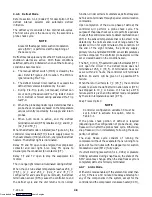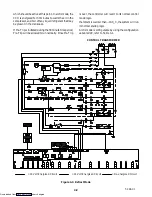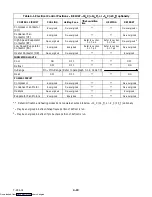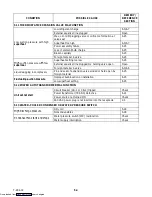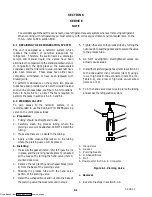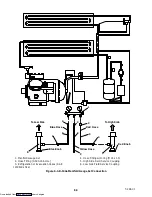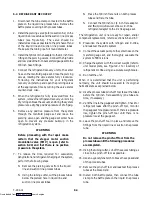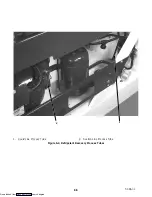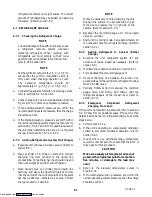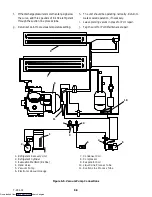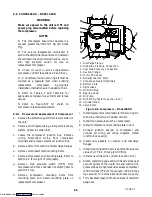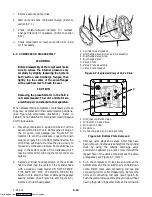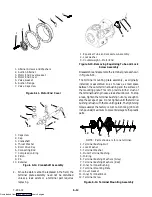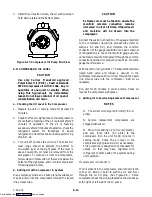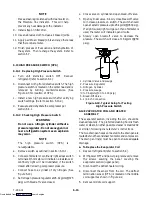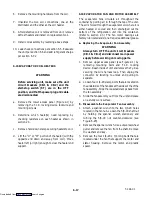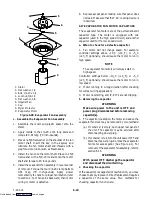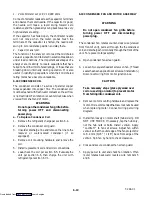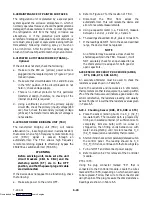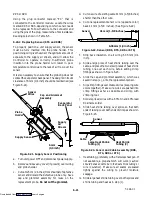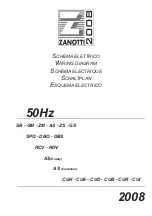
6-6
T-294-01
6.5 REFRIGERANT LEAK CHECKING
WARNING
Never mix refrigerants with air for leak
testing. It has been determined that
pressurized,
air-rich
mixtures
of
refrigerants
and
air
can
undergo
combustion when exposed to an ignition
source.
a. The recommended procedure for finding leaks in a
system is with a R-134a electronic leak detector.
b. If the system is without refrigerant, refer to sections
6.3 and 6.4 and, charge the system with refrigerant
to build up pressure between 2.1 to 3.5 kg/cm
@
(30
to 50 psig). Remove refrigerant cylinder and
leak-check all connections.
NOTE
It must be emphasized that only the correct
refrigerant cylinder be connected to pressurize
the system. Any other gas or vapor will
contaminate the system, which will require
additional purging and evacuation of the
system.
c. Remove refrigerant using a refrigerant recovery
system and repair any leaks.
d. Evacuate and dehydrate the unit. (Refer to section
6.6.)
e. Charge unit per section 6.7.
6.6 EVACUATION AND DEHYDRATION
6.6.1
General
Moisture is the deadly enemy of refrigeration systems.
The presence of moisture in a refrigeration system can
have many undesirable effects. The most common are
copper plating, acid sludge formation, “freezing-up” of
metering devices by free water, and formation of acids,
resulting in metal corrosion.
6.6.2
Preparation
a. Evacuate and dehydrate only after pressure leak
test. (Refer to section 6.5.)
b. Install manifold gauges (refer to section 6.3), and
recover the refrigerant (refer to section 6.4).
c. Essential tools to properly evacuate and dehydrate
any system include a vacuum pump (8 m
3
/hr = 5
cfm volume displacement, P/N 07-00176-01) and
electronic vacuum gauge.
d. If possible, keep the ambient temperature above
15.6
_
C (60
_
F) to speed evaporation of moisture. If
the ambient temperature is lower than 15.6
_
C
(60
_
F), ice might form before moisture removal is
complete. Heat lamps or alternate sources of heat
may be used to raise the system temperature.
e. To help speed up the evacuation procedure, replace
the filter-drier with a section of 3/8 inch ID copper
tubing.
6.6.3
Procedure
a. Remove all refrigerant using a refrigerant recovery
system.
b. The recommended method to evacuate and
dehydrate the system is to connect two evacuation
hoses, as shown in Figure 6-5, to the vacuum pump
and refrigeration unit. DO NOT use standard
service hoses, as they are not suited for evacuation
purposes. Also as shown, connect a evacuation
manifold, with evacuation hoses only, to the
vacuum pump, electronic vacuum gauge, and
refrigerant recovery system.
c. With the manifold gauge hand valves back seated,
and the vacuum pump and electronic vacuum gauge
valves open, start the pump and draw a deep
vacuum. Shut off the pump and check to see if the
vacuum holds. This operation is to test the
evacuation setup for leaks. Repair if necessary.
d. Open the vacuum pump and electronic vacuum
gauge valves, if they are not already open. Start the
vacuum pump. Evacuate unit until the electronic
vacuum gauge indicates 2000 microns. Close the
electronic vacuum gauge and vacuum pump valves.
Shut off the vacuum pump. Wait a few minutes to
be sure the vacuum holds.
e. Break the vacuum with clean dry refrigerant gas.
Use refrigerant specified for the unit. Raise system
pressure to approximately 2 psig, monitoring it
with the compound gauge.
f. Remove refrigerant using a refrigerant recovery
system.
g. Repeat steps (e) through (g) one time.
h. Remove the copper tubing and change the
filter-drier. Evacuate unit to 500 microns. Close the
electronic vacuum gauge and vacuum pump valves.
Shut off the vacuum pump. Wait five minutes to see
if vacuum holds. This procedure checks for residual
moisture and/or leaks.
i. With a vacuum still in the unit, the refrigerant
charge may be drawn into the system from a
Downloaded from


